A Scalable Two Stage Approach to Computing Optimal Decision Sets
DOI:
https://doi.org/10.1609/aaai.v35i5.16498Keywords:
Satisfiability, Rule Mining & Pattern Mining, Classification and Regression, Knowledge Representation LanguagesAbstract
Machine learning (ML) is ubiquitous in modern life. Since it is being deployed in technologies that affect our privacy and safety, it is often crucial to understand the reasoning behind its decisions, warranting the need for explainable AI. Rule-based models, such as decision trees, decision lists, and decision sets, are conventionally deemed to be the most interpretable. Recent work uses propositional satisfiability (SAT) solving (and its optimization variants) to generate minimum-size decision sets. Motivated by limited practical scalability of these earlier methods, this paper proposes a novel approach to learn minimum-size decision sets by enumerating individual rules of the target decision set independently of each other, and then solving a set cover problem to select a subset of rules. The approach makes use of modern maximum satisfiability and integer linear programming technologies. Experiments on a wide range of publicly available datasets demonstrate the advantage of the new approach over the state of the art in SAT-based decision set learning.Downloads
Published
2021-05-18
How to Cite
Ignatiev, A., Lam, E., Stuckey, P. J., & Marques-Silva, J. (2021). A Scalable Two Stage Approach to Computing Optimal Decision Sets. Proceedings of the AAAI Conference on Artificial Intelligence, 35(5), 3806-3814. https://doi.org/10.1609/aaai.v35i5.16498
Issue
Section
AAAI Technical Track on Constraint Satisfaction and Optimization

